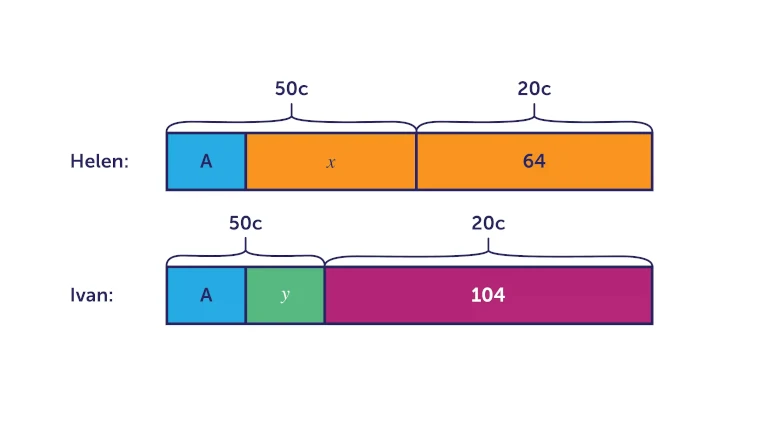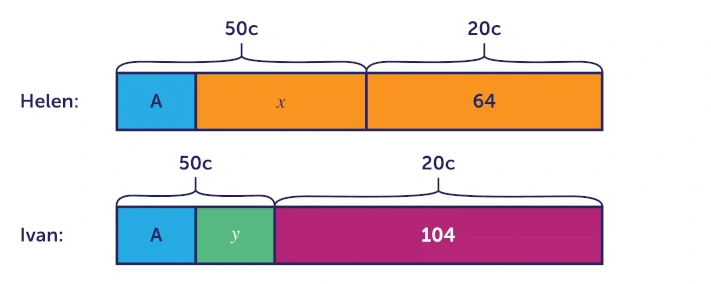2021 PSLE Maths coin question: Simplest solution
- Tags:
- Primary Maths

Have you ever been given a complex Maths problem that seemed daunting at first, but then turned out to be quite simple? That's exactly what we're going to explore in this blog. We'll be looking at a seemingly complex Maths problem that involves calculating the mass of coins, but with a little bit of logic and some basic Maths skills, it becomes a breeze.
Specifically, we'll be answering the Helen and Ivan Coin question that stumped many students during the 2021 Maths exam.
Let's look at the question first:
Question:
Helen and Ivan had the same number of coins. Helen had a number of \(\text{50-cent}\) coins and \(\text{64 20-cent}\) coins. These coins had a mass of \(\text{1.134 kg}\). Ivan had a number of \(\text{50-cent}\) coins and \(\text{104 20-cent}\) coins.
- Who has more money in coins and by how much?
- Given that each \(\text{20-cent}\) coin is \(\text{2.7 g}\) heavier than \(\text{50-cent}\) coin, what’s the mass of Ivan’s coins in \(\text{KG}\)?
Answer:
In order to answer this, let’s try to draw this problem, so we can understand what's being asked.

Let’s look at the question again.
If you notice closely, the first line of the question mentions that Helen and Ivan have the same number of coins.
Keep this in mind.
Now, for the first question, we want to know who has more money and by how much.
Since we know the number of \(\text{20-cent}\) coins both Helen and Ivan have, we can start solving our question using these numbers.
Helen: \(64\)
Ivan: \(104\)
Let’s calculate the difference.
We can see that Ivan has \(40\) more \(\text{20-cent}\) coins than Helen \(\text{(104-64)}\)
Since the number of coins for both is the same, we can conclude that Helen has \(\text{40 50-cent}\) coins more than Ivan.
That’s all the information that we have.
Now, we know that there’s a difference of \(40\) coins.
Ivan has \(\text{40 20-cent}\) coins more than Helen \(\text{(40}\times \text{20) cents = 800 cents}\), and
Helen has \(\text{40 50-cent}\) coins more than Ivan \(\text{(40}\times \text{50) cents = 2000 cents}\).
So, clearly, Helen has \(\text{1200 cents (or \$12)}\) more than Ivan.
That’s our answer.
Let’s look at the next question, this time we need to look at the \(mass\) of the coins.
Except for those \(\text{40 extra coins}\), the mass of coins that Helen and Ivan have is the same.
Since,
\(\text{50-cent}\) coins are \(\text{2.7 gm}\) heavier than \(\text{20-cent}\) coins,
we can say that,
Helen’s coins weighed \((40 \times 2.7) \text{ gm} = 108 \text{ gm}\) heavier than Ivans’.
Given that,
Total mass of Helen’s coins is \(\text{1.134 kg}\) or \(\text{1134 gm}\),
the mass of Ivan’s coins would be \(1124 - 108 = 1016 \text{ gm}\) or \(1.026 \text{ kg}\).
Doesn’t it all make sense when it’s explained?
If you’d like more practice solving Maths problems, try Geniebook Arena!
In Arena, students have the opportunity to join forces with their friends in a quest to conquer challenging Maths and Science problems on a daily basis. To participate, simply invite your friends and create a team to compete for a spot on the global leaderboard.


 SG
SG  VN
VN 




















